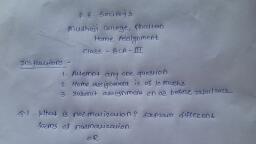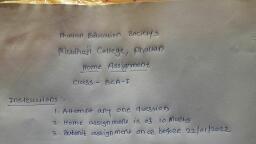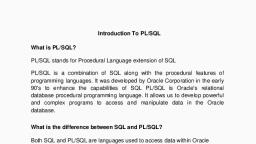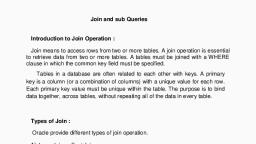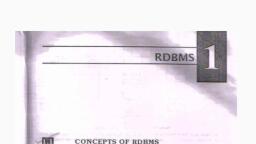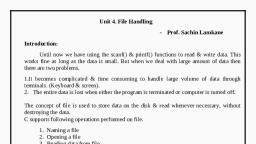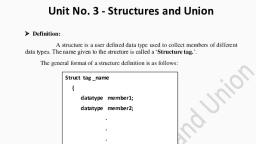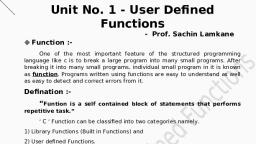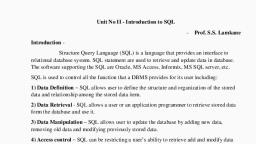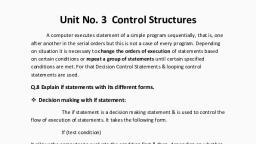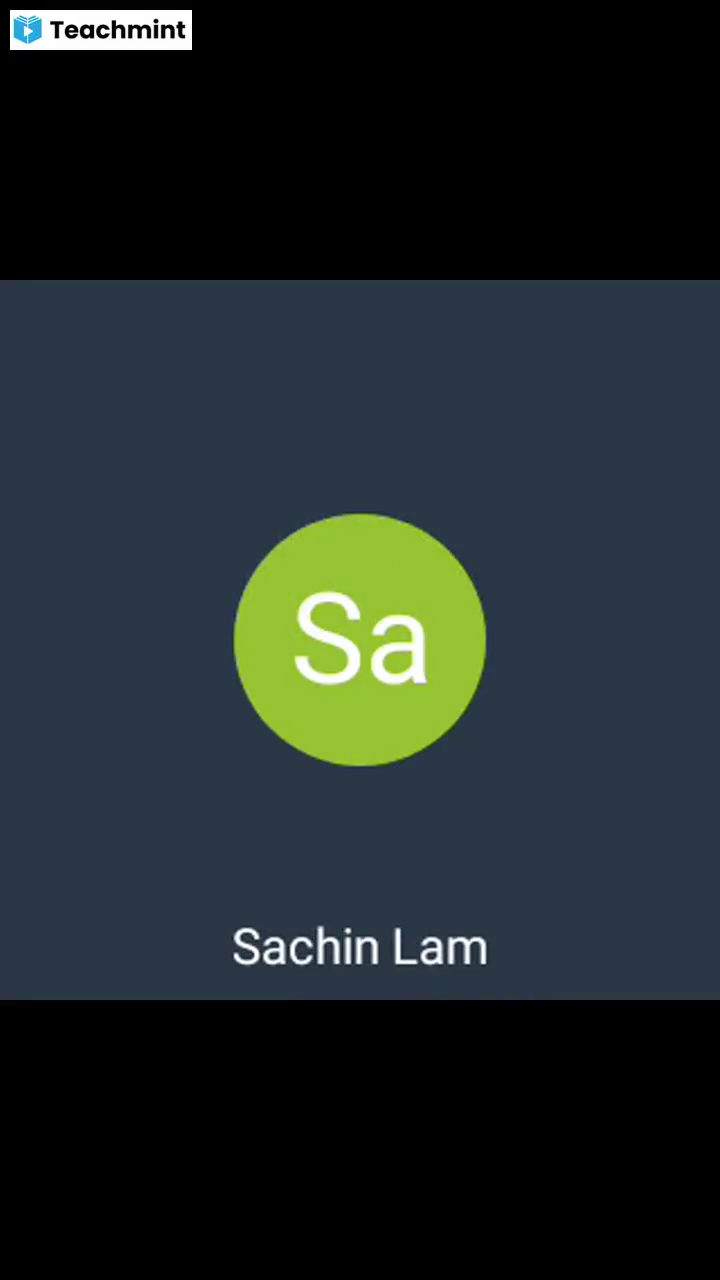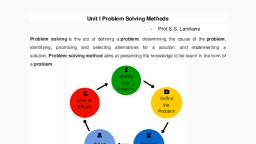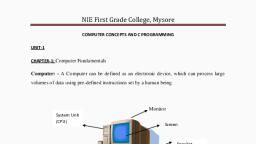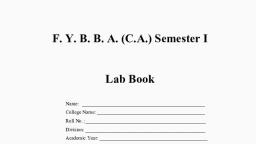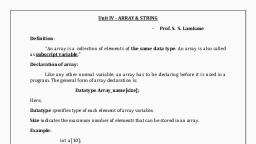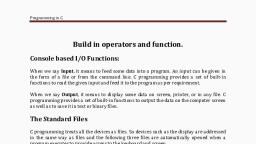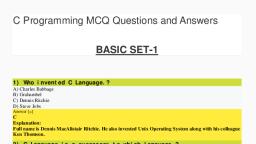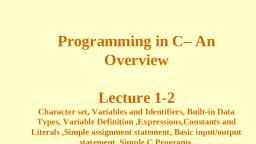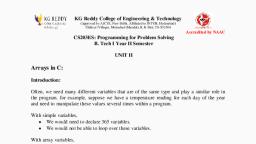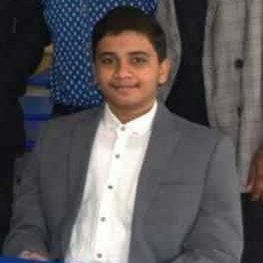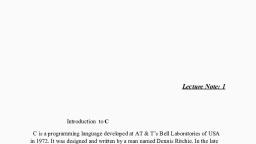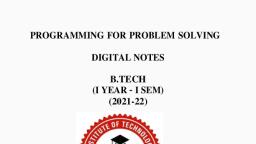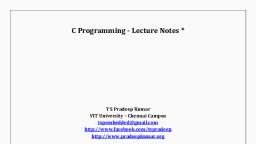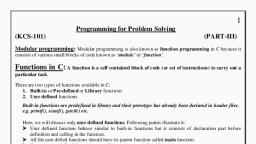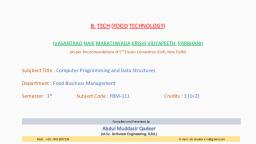Page 1 :
Unit IV - ARRAY & STRING, -, , Prof. S. S. Lamkane, , Definition:, “An array is a collection of elements of the same data type. An array is also called, as subscript variable.”, Declaration of array:, Like any other normal variable, an array has to be declaring before it is used in a, program. The general form of array declaration is:, Datatype Array_name[size];, Here,, Datatype specifies type of each element of array variable., Size indicates the maximum number of elements that can be stored in an array., Example:, int a[10];, Declares the ‘a’ as array variable of type integer & which is able to store 10 integer, numbers. When array is declared, continuous memory is allocated for the array elements., For above declaration following is the memory allocation., a[0], 1000, , a[1], 1002, , a[2], 1004, , a[3], 1006, , a[4], 1008, , a[5], 1010, , a[6], , a[7], , a[8], , a[9], , 1012, , 1014, , 1016, , 1018, , Fig: Memory Allocation of Array, Assume that the starting address of array is 1000. Every integer requires 2 bytes, memory. So next address is 1002, 1004 & so on., Initialization of an Array:, After the declaration of array, its element must be initialized. Otherwise, they will, contain ‘garbage’ value. An array can be initialized at either of the following ways., 1. At compile time, 2. At run time., 1. Compile time Initialization:, We can initialize the elements of array in the same way as the ordinary variable, when they are declared. Compile time initialization is also known as Static Binding or, early binding. The general form of initialization of array is:, int a[5]={2, 5, 3, 4, 7};, , 1
Page 2 :
Example: 1. float total [5]={1.5, 15.70, -10.0};, It will initialize the first three elements to 1.5, 15.70, -10.0 & the remaining two elements to, zero., Example: 2. int counter[]={ 1, 2, 3, 4 };, Here, size of array is omitted. In such case the compiler allocates enough space for, initializes elements., Example: 3. char name[]={’J’, ’o’, ’h’, ’n’ , ’\0’ };, Declares the name to be an array of five characters, initialized with string “John” & ending, with the null character back slash zero ‘\0’., Example: 4. int a[3]={ 10, 20, 30, 40 };, It is illegal in c, because if we have more initialization than the declared size, the compiler, will produce an error., 2. Run time Initialization:, An array can be explicitly initialized at the run time. This type of initialization is, usually applicable in large array. Run time initialization is also known as dynamic binding, or late binding. Consider the following c code which is used to initialize array as run time., int a[10];, for( i=0; i<10; i++ ), {, scanf(“%d”, &a[i]);, }, With initialization, array elements with the values entered through the keyboard., Sample programs:, 1. Write a c program to accept ‘n’ numbers. Store this numbers in an array & display, only even numbers., #include<stdio.h>, #include<conio.h>, void main(), {, int no[50], n, i;, clrscr();, printf(“\n Enter how many numbers: ”);, scanf(“%d”, &n);, printf(“\n Enter the numbers: ”);, for(i=0;i<n;i++), {, scanf(“%d”,&no[i]);, printf(“\n The even numbers are: ”);, for(i=0;i<n;i++), {, 2
Page 3 :
}, }, O/P, , if(no[i]%2==0), printf(“\t %d ”, no[i]);, , }, getch();, , Enter how many numbers : 5, Enter the numbers : 6, The Even Numbers are : 6, , 5, , 8, 8, , 10, , 9, , 10, , 2. Write a c program to convert decimal number to it’s equivalent binary number., #include<stdio.h>, #include<conio.h>, void main(), {, int no, Bin[16], i;, clrscr();, for(i=0;i<16;i++), {, Bin[i]=0;, printf(“\n Enter the Decimal Number: ”);, scanf(“%d”, &no);, i=0;, while(no>0), {, Bin[i]=no%2;, i++;, no=no/2;, }, }, printf(“\n The Binary equivalent is: ”);, for(i=15;i>=0;i--), {, printf(“\n %d”, Bin[i]);, }, getch();, }, O/P, Enter the Decimal Number: 15, The Binary equivalent is : 0000000000001111, , 3
Page 4 :
Two Dimensional Array:, Two dimensional array has 2 subscripts. One indicates the row & other indicates the, column. i.e. two dimensional array is used to store elements in the form of table. Tabular, representation of array is also known as matrix., The general form of two dimensional array is as follows:, Datatype Array_name[row_size][col_size];, For example:, , int a[3][2];, , Here, ‘a’ is declared as a two dimensional array having 3 rows & 2 columns. i.e. used to, store 6 elements., Initialization of two dimensional array:, Like a one dimensional array, two dimensional array can be initialized in two ways., Col 0, 1. Compile time initialization, 2. Run time initialization, , Row 0, Row 1, Row 2, , col 1, , col 2, , (0,0) (0,1) (0,2), (1,0) (1,1) (1,2), (2,0) (2,1) (2,2), , 1. Compile time initialization:, There are two different forms of compile time initialization, a. int a[3][2]= {, , };, , { 1, 2 },, { 5, 3 },, { 4, 2 }, , b. int a[3][2]={ 1, 2, 5, 3, 4, 2 };, both represented logically as,Col 0 Col 1, Row 0, 1, 2, Row 1, 5, 3, Row 2, 4, 2, Consider the following code:int a[3][2];, for(i=0;i<3;i++), {, for(j=0;j<2;j++), {, scanf(“%d”, &a[i][j]);, }, }, , 4
Page 5 :
Here, two for loops are used to initialize two dimensional array. First for loop, represents rows & second for loop represents column., Memory representation of two dimensional array:, Like a one dimensional array, continuous memory is allocated for two dimensional array as, for above example:, |------------Row1----------- |-------------Row2------------|------------Row3-----------|, 1, 2, 5, 3, 4, 2, 1000, 1002, 1004, 1006, 1008, 1010, Fig: Memory allocation, Example:, 1. write a c program for transpose of a matrix., (The transpose of a matrix is a matrix with the rows & columns of the original, matrix interchange.), #include<stdio.h>, #include<conio.h>, void main(), {, int m[5][5], trans[5][5], r, c, i, j;, clrscr();, printf(“\n How many rows & columns in the matrix: ”);, scanf(“%d%d”, &r, &c);, printf(“\n Enter the array elements: ”);, for(i=0;i<r;i++), {, for(j=0;j<r;j++), {, scanf(“%d”, &m[i][j]);, trans[j][i]=m[i][j];, }, }, printf(“\n The transpose matrix is: ”);, for(i=0;i<c;i++), {, for(j=0;j<r;j++), {, printf(“%d \t”,trans[i][j]);, }, }, getch();, }, O/P, , How many rows & columns in the matrix: 3 3, Enter the array elements: 1, 2 3, 4, 5 6, 7, 8 9, 5
Page 6 :
The transpose matrix is:, 1 4 7, 2 5 8, 3 6 9, , , What is string? How it is declared & initialized?, , String:, A string is the sequence of characters that is treated as a single data item., String Operations:, Following are the common operations performed by the string., 1., 2., 3., 4., 5., , Read & write string, Combining string together, Coping one string to another, Comparing string for equality, Finding length of string, , Declaration & initialization of string variable:, C language does not support string as a datatype, it is represented in the form of, character array. The general form of declaration of a string variable is:, char StringName[size];, For example:, , , , char name[20];, char city[25];, , What is the string? Explain the syntax of initialization, declaration & example., , Initialization:, Like numeric array, character array (i.e. string) may be initialized when they are, declared. Character array can be initialized in either of the following two forms., char city[10]=”phaltan”;, char city[10]={ ’p’, ’h’, ’a’, ’l’, ’t’, ’a’, ’n’, ’\0’ };, in second type of initialization,’\0’ is the null termination character. In first, example compiler automatically supplies a null character (‘\0’) at the end of the string., Reading string from terminal:, The input function scanf() can be used with %s format specification to read in a, string of character., For example:, char city[10];, Scanf(“%s”,city);, 6
Page 7 :
The problem with the scanf() function is that, it is terminates it’s input on the first, white space it finds. Therefore, if the following line of text is typed in at the terminal,, New York, Then only the string “New” will be read into the array city, since the blank space after the, word “New” will terminate the string reading., Another library function gets() is used to read input string from terminal including, white space. The general form of gets() function is,, gets(str);, Here, str is a string variable. It read characters into str from the keyboard until a, new line character is encountered & then appends null character to the string., For example:, , char line[80];, gets(line);, printf(“%s”,line);, reads a line of text from the keyboard & display it on the screen., Writing string to screen:, The output function printf() is used with %s format to print strings to the screen., For example:, , printf(“%s”,city);, , can be used to display the contents of city., Another & more convenient way of printing string values is to use the function, puts() declared in the header file <stdio.h>.following are the syntax of puts() function., puts(str);, where str is a string variable containing a string value., For example:, , , , char city[50];, gets(city);, puts(city);, , Explain different string handling functions with example, , String handling function:, Following are the most commonly used string handling functions:, strcat();, strcmp();, strcpy();, strlen();, strrev();, , concatenates two strings, compares two strings, copy one string to another0, finds the length of string, reverse the string, 7
Page 8 :
1. strcat() function:, The strcat() function jobs two strings together. It takes the following form:, strcat(string1, string2);, string1 & string2 are character array when the function strcat is executed string2 is, appended to string1., For example:, Part1, V, E, R, Y, \0, Part2, , G, , O, , O, , D, , \0, , Execution of statement:, strcat(part1, part2);, with result:, Part1 =, , V, , E, , R, , Y, , Part2=, , G, , O, , O, , D, , G, , O, , O, , D, , \0, , \0, , We must make sure that the size of string1 is larger enough to accommodate, the final string., 2. strcmp() function:, The strcmp() function compares two string., If they are not equal, it returns numeric difference between the first non-matching, characters in the string. It takes following form., strcmp(string1, string2);, string1 & string 2 are string variables or string constants., For example:, strcmp(“their”, “there”);, will return a value -9 which is the numeric difference between ASCII “i" & ASCII ”r”., strcmp(“RAM”, “RAM”);, will return a value 0. Because above strings are equal., 3. strcpy() function:, The strcpy() function copies one string into another string., It takes the following form:, strcpy(string1, sting2);, here, contents of string2 is copied into string1., For example:, strcpy(city, “phaltan”);, will assign the string “phaltan” to the string variable city., , 8
Page 9 :
4. strlen() function:, This function counts & returns the number of characters in a string., It takes following form:, n=strlen(string);, where, n is an integer variable, which stores the value of the length of a string, returned by strlen() function., 5. strrev() function:, This function is used to reverse the string & returns the reversed string., It takes following form:, s=strrev(string1);, where, s is a string variable that stores reverse string of string1., For example:, string1=”Phaltan”;, s=strrev(string1);, Now, s contains “natlahp”., Program:, Demonstrate the use of above function., , , s1, s2 & s3 are three string variables. Write a program to read two string constant, into s1 & s2 & compare whether they are equal or not? If they are not equal join, them together. Then copy the contents of s1 to the variable s3. Then reverse the, string s1 & check whether it is palindrome or not? Finally print the contents of all, the 3 variables & there lengths., #include<stdio.h>, #include<conio.h>, #include<string.h>, void main(), {, char s1[20], s2[20], s3[20];, int x, l1, l2, l3;, clrscr();, printf(“\n Enter two strings: ”);, scanf(“%s%s”, s1, s2);, x=strcmp(s1, s2);, /* compare string */, if(x==0), {, Printf(“\n String s1 & s2 are equal ”);, }, else, {, printf(“\n Strings are not equal ”);, 9
